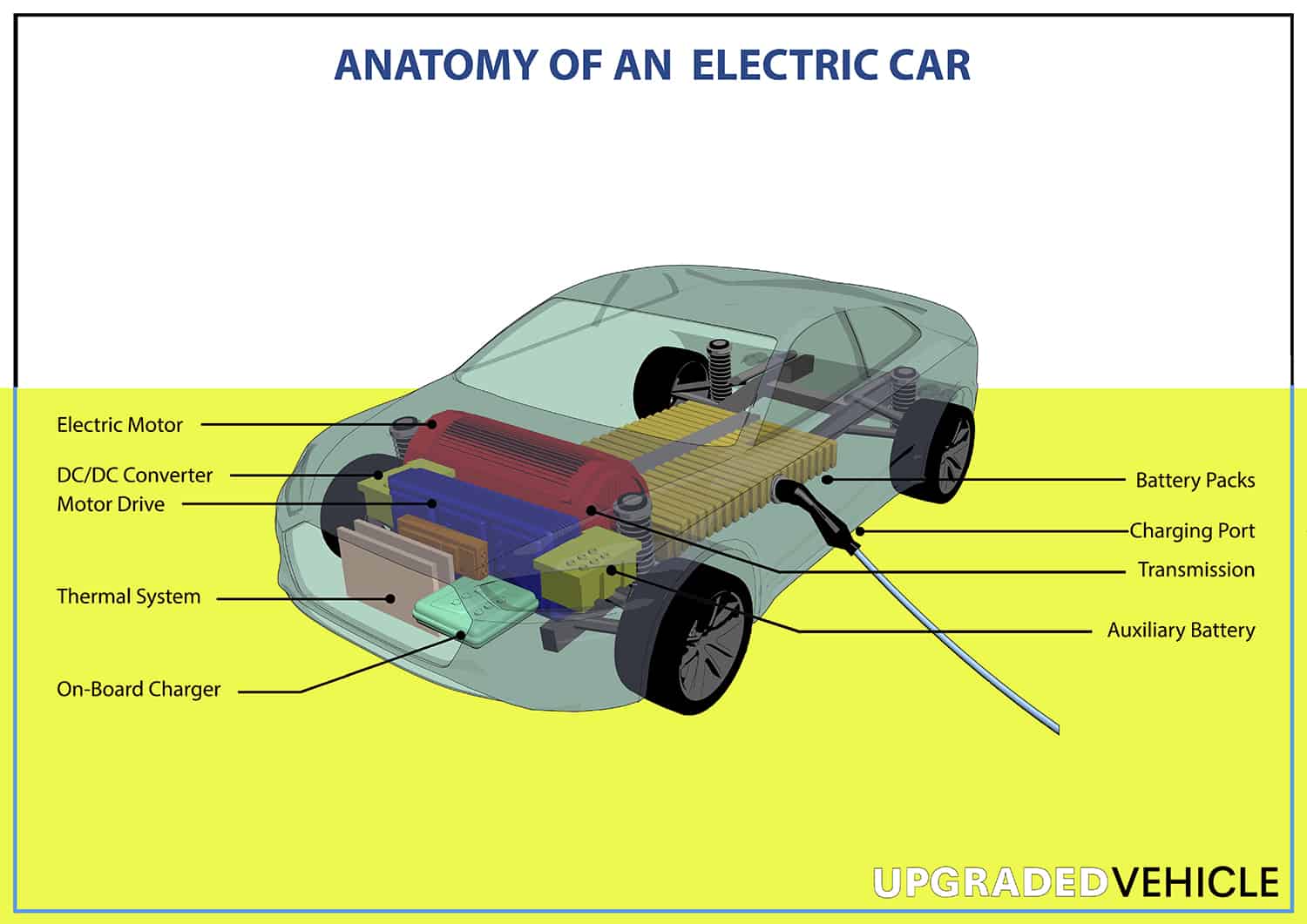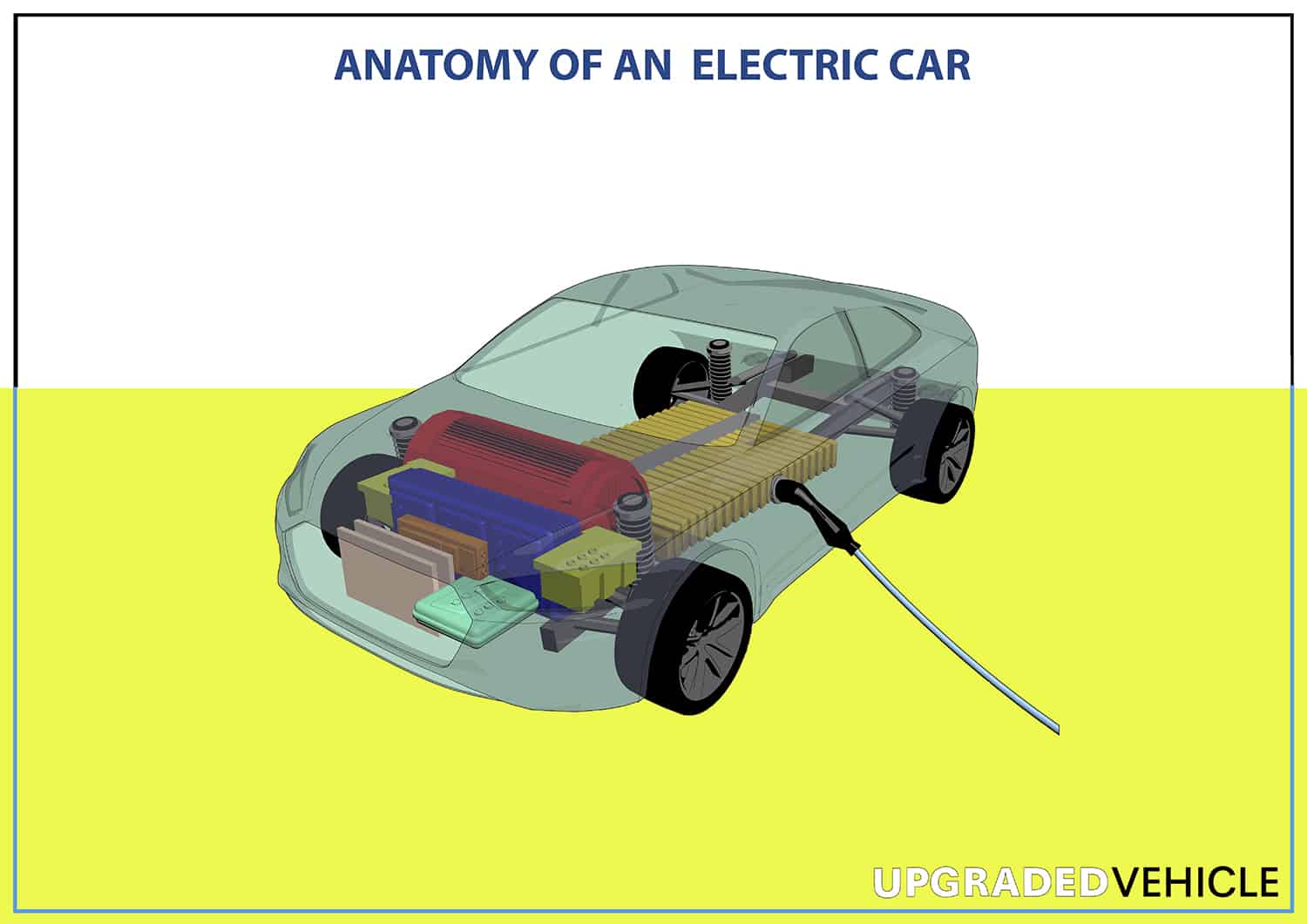Electric cars are revolutionizing the automotive industry with their eco-friendly technology and high performance. The heart of these technologically advanced machines lies in their unique components, which work together to create a seamless and efficient driving experience distinct from that of their gasoline-powered counterparts.
The core components of an electric car are the electric motor, power electronics controller, and battery pack. Secondary components of an electric vehicle (EV) Include the regenerative braking system, the thermal management system, the DC/DC converter, charging ports, and the battery management system.
This guide will discuss these essential parts, as well as the various design elements and features that make EVs stand out. You can refer to the diagram below to get a visual look at the electric car’s anatomy.

The EV Revolution
Electric Vehicles operate on electric power stored in batteries, replacing the traditional internal combustion engine. Unlike gasoline-powered cars, EVs don’t require oil changes, spark plugs, or fuel filters, which lowers maintenance costs. Their power sources are diverse, ranging from solar panels to electricity grids, making them adaptable to different energy landscapes.
Charging infrastructure has a significant role in the EV revolution. It includes home charging stations, public charging stations, and fast-charging stations. While most EV charging happens at home, public and fast-charging stations are vital for long-distance travel and for those without access to home charging.
Electric vehicles are a significant step toward reducing carbon footprints. They produce no tailpipe emissions and, when powered by renewable energy, can be virtually carbon-neutral. Additionally, EVs are more energy-efficient than their gasoline counterparts. They can convert a larger portion of the electrical energy from the grid to power at the wheels.
Core Components of an Electric Car
EVs represent a significant shift from traditional vehicles. This shift involves a considerable change in vehicle design and components. Here, we will look into the core components of an electric car.
1. Electric Motor
The electric motor is the linchpin of an EV, replacing the internal combustion engine of a conventional car. There are two main types of motors used in EVs: AC (Alternating Current) motors and DC (Direct Current) motors.
These motors convert electrical energy to mechanical power, propelling the vehicle forward. Electric motors are efficient, silent, and require less maintenance than gasoline engines.
2. Power Electronics Controller
This component regulates the electrical energy supplied to the motor. It takes power from the battery and manages the speed and torque of the motor through a process called pulse-width modulation. This regulation ensures optimal energy use and extends the vehicle’s driving range.
3. Battery Pack
The electric car battery, which can weigh as much as half a ton, is the EV’s fuel tank. It stores the electrical energy that powers the motor. Most electric vehicles use lithium-ion batteries due to their high energy density, long life span, and lightweight.
These rechargeable batteries are made up of numerous cells that store and release electricity. Battery capacity, often measured in kilowatt-hours (kWh), determines the electric car’s range – how far it can drive on a single charge.
Secondary Systems and Components
There are also secondary systems and components of electric cars worth learning about:
1. Regenerative Braking System
One unique feature of EVs is the regenerative braking system; instead of wasting energy as heat when braking, as in traditional cars, regenerative braking converts some of the vehicle’s kinetic energy back into electrical energy, which is then stored in the battery for future use. This system improves energy efficiency and extends the driving range of the EV.
2. Thermal Management System
Batteries and motors generate heat, especially during rapid charging or high-speed driving. The thermal management system keeps these components within optimal operating temperatures. It uses coolants and air flow methods to prevent overheating, ensuring the longevity and safety of the components.
3. Transmission System
When it comes to electric cars, the transmission system is quite different from those found in traditional internal combustion engine (ICE) vehicles. Electric cars often have simpler transmission systems, which can be either single-speed or multi-speed. I
4. Onboard Charger
The onboard charger is an essential component of your electric vehicle’s charging system. It converts alternating current (AC) from your charging station or wall outlet into direct current (DC), which is required to charge your vehicle’s battery.
The charging speed depends on your EV’s onboard charger capacity and the power supply at the charging point. Usually, Level 1 and Level 2 charging stations use onboard chargers.
Level 1 Charging is the most basic and slowest method, but it’s also very convenient as you can plug it into any 120V household outlet. Charging time varies depending on your EV’s battery capacity, but expect it to take several hours or more.
Level 2 Charging offers faster charging compared to Level 1, as it uses a 240V supply, similar to what electric dryers and stoves use. You can find Level 2 charging stations at public spaces or even install one at your home. Keep in mind that installation costs, charging times, and electricity tariffs will depend on your location and utility company.
5. Charging Port
The charging port serves as the connection point between the vehicle and the power source during charging. This inlet is designed to accommodate a plug from a charging cable and safely carry the electric current to the vehicle’s onboard charger.
Many electric cars also feature a Combined Charging System (CCS) port. This combines the traditional AC charging port with an additional section for DC fast charging. This dual-purpose design allows the vehicle to be charged from various types of charging stations.
6. DC/DC Converter
The DC/DC converter connects the high-voltage battery to the car’s low-voltage systems, such as lights, audio systems, and dashboard displays. It steps down the high voltage from the battery to a lower voltage suitable for these systems.
7. Battery Management System
The Battery Management System (BMS) ensures safe and efficient use of the battery pack. It monitors battery conditions like voltage, current, temperature, and state of charge. The BMS protects the battery from damage due to overcharging, overheating, or excessive discharging.
8. Auxiliary Battery
In addition to the main battery pack, your electric car has an auxiliary battery that powers the vehicle’s accessories, such as lights, air conditioning, and infotainment systems. This separate battery ensures that the main battery pack can dedicate its energy to propelling the car, maximizing your driving range.
9. Motor Drive
The motor drive is an essential component in electric vehicles, providing the necessary voltage and current to power the electric motor. It also manages the speed and torque, allowing your car to respond to different driving conditions efficiently.
Electric Vehicle Design Elements and Features
Electric cars stand out not only for their innovative powertrain components but also their unique design elements and features. Let’s take a look at these distinctive aspects that define the overall user experience and efficiency of EVs.
Aerodynamic Design
The goal of aerodynamics is to reduce air resistance (drag) as the car moves forward, allowing the vehicle to travel further on a single charge. This is why many electric cars feature streamlined shapes, flush door handles, and even covered wheel arches.
Battery Placement
In most electric cars, the battery pack is located in the vehicle’s floor. This low and central placement has multiple benefits. It lowers the vehicle’s center of gravity, enhancing stability and handling. It also allows for a flat interior floor, providing more cabin space and flexibility in seating and storage arrangements.
Quiet Operation
Electric motors are remarkably quiet compared to traditional combustion engines. This results in a significantly quieter ride, reducing both internal cabin noise and external noise pollution. Some manufacturers enhance this quiet experience with additional sound insulation and noise-canceling technologies.
Instant Torque
Electric motors deliver 100% of their torque instantly from a standstill. This results in swift acceleration, often outperforming conventional gasoline vehicles. This instant torque delivery also allows for smoother and more responsive handling at lower speeds.
Digital Connectivity
Many electric vehicles come equipped with advanced infotainment systems and digital connectivity options. These systems offer features such as navigation optimized for electric driving, real-time charging station updates, and remote control of charging and climate settings via smartphone apps.
Smart Charging
Electric vehicles feature smart charging technology. This system can schedule charging during off-peak electricity periods to save on energy costs. Some systems can even integrate with home energy management systems to optimize charging based on the home’s overall energy consumption.
Autonomous Driving Features
While autonomous driving is not exclusive to electric vehicles, many EV manufacturers are leading the way in this technology. Advanced driver-assistance systems (ADAS) are increasingly common, offering features such as adaptive cruise control, automatic emergency braking, and lane-keeping assist. Some vehicles are also equipped for semi-autonomous or fully autonomous driving.
LED Lighting
LED (Light Emitting Diode) lights are a common feature in electric vehicles. LEDs consume less energy than traditional halogen or xenon lamps, thus conserving the vehicle’s battery life. Their compact size also offers designers more flexibility, contributing to the sleek and modern aesthetic of EVs.
Heat Pump System
While traditional vehicles generate heat as a byproduct of combustion, electric vehicles need a dedicated system for heating the cabin. Many EVs use a heat pump system, which is more energy-efficient than conventional electric heaters. Some models can even precondition the cabin to a comfortable temperature while the car is still plugged in, saving battery energy for driving.

